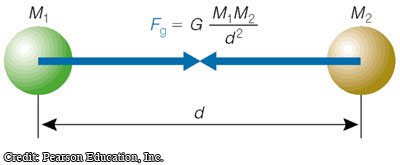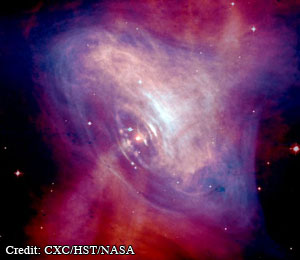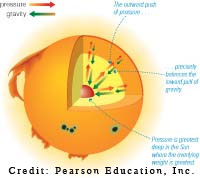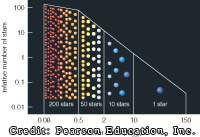
A Star is BornA Star is Born
Summary: Stars form in cold, dense regions of space called molecular clouds. When the force of gravity pulling in on the cloud is greater than the strength of internal pressure pushing out, the cloud collapses into a protostar.
Where do stars form?
Why do stars form?
What slows the cloud collapse?
Nuclear Fusion
Masses of Newborn Stars
Related links
Related Lessons:
Astro-Chronology
WHERE DO STARS FORM?
Stars form in the densest regions of the interstellar medium, or ISM, called molecular clouds. The ISM is the name given to the gas and dust that exists between the stars within a galaxy. It is 99% gas and 1% dust, by mass.
- 70% hydrogen
- 28% helium
- 2% elements heavier than helium
Molecular clouds are perfect star-forming regions because the combination of these atoms into molecules is much more likely in very dense regions.
This photograph shows the Orion Nebula, an interstellar cloud in which star systems - and possibly planets - are forming. Our own solar system presumably formed as gravity caused the collapse of a similar large cloud of gas. The piece of cloud that formed our Solar System is known as the solar nebula.
Click the photo to the left to see more images of the Orion Nebula.
WHY DO STARS FORM?
A star forms when a molecular cloud collapses under its own gravity forming a dense core sustained by nuclear fusion. This happens only when the force of gravity pulling in exceeds the outward push of pressure. High-density molecular clouds have stronger forces of gravity pushing in, making it easier to overcome the total pressure within the cloud.
SHOW ME
THE MATH
Once started, the collapse of the solar nebula continues because the force of gravity exerted on the cloud grows stronger as the cloud shrinks in size. The universal law of gravitation is written mathematically:

Fg is the force of gravitational attraction, M1 and M2 are the masses of the two objects, and d is the distance between their centers. The symbol G is known as the gravitational constant. Its value is G = 6.67 · 10-11kg·m2/s2.
Before its collapse began, the gas that made up the solar nebula was probably spread out over a roughly spherical region a few light-years in diameter. This gas was extremely low in density and extremely cold.
- Shock wave from a nearby exploding star
- Collision of 2 molecular clouds
This is a picture of the Crab Nebula taken with the Hubble Space Telescope. The Crab Nebula was created when a star exploded. Our Solar System is thought to have formed from particles expelled from a supernova explosion over 4 billion years ago.

As the solar nebula shrinks in size, its density, temperature and shape all undergo dramatic changes.
HEATING: The temperature of the solar nebula increases as it collapses. As the cloud shrinks, its gravitational potential energy is converted to the kinetic energy of individual gas particles falling inward. These particles crash into one another, converting their kinetic energy into thermal energy.
SPINNING: Like an ice skater pulling in her arms as she spins, the solar nebula rotates faster and faster as it shrinks in radius. This increase in rotation rate represents conservation of angular momentum. The rotation of the cloud may have been imperceptibly slow before its collapse began, but the cloud's shrinkage makes fast rotation inevitable.
SHOW ME
THE MATH
FLATTENING: The solar nebula has flattened into a disk. This flattening is a natural consequence of collisions between particles in a spinning cloud. A cloud may start with any size or shape, and different clumps of gas within the cloud may be moving in random directions at random speeds. When the cloud collapses, these different clumps collide and merge, resulting in a flattened rotating disk.
WHAT SLOWS THE CLOUD COLLAPSE?
As the collapse continues, density increases and the molecules inside begin to interact more and more. This extra interaction causes the temperature to increase. Since pressure depends on density and temperature (see SHOW ME THE MATH), the pressure increases.
SHOW ME
THE MATH
Once the pressure gets high enough, it begins to rival the strength of gravity and the collapse of the cloud slows down. Eventually, the cloud of gas becomes a protostar: an infant star that has not yet begun to fuse hydrogen in its core.
NUCLEAR FUSION
A protostar is not considered a star until it gets its energy from nuclear fusion instead of gravitational contraction. Gravitational contraction is the process of a cloud's gravity overcoming its internal pressure and causing a collapse. The core temperature of an object must reach a minimum temperature before the atoms inside will fuse.
- Hydrogen to fuse into helium: 10 million °Kelvin
- 3 helium nuclei to fuse into carbon: 100 million °Kelvin
The rate of fusion increases until the amount of energy produced in the core equals the amount of energy radiated from the surface. The perfect balance between energy produced and energy released stops the protostar from collapsing further.
MASSES OF NEWBORN STARS
The number of low-mass stars is much higher than the number of high-mass stars.
- Minimum mass of newborn star: 0.08 times the mass of the Sun
- Maximum mass of newborn star: 150 times the mass of the Sun
The diagram shows the relative number of stars for every high-mass star. For every star 10-150 times the mass of our Sun, there are 50 stars close to the mass of our Sun. Our Sun is pretty average in size and mass.
LINKS TO MORE PICTURES OF MOLECULAR CLOUDS AND STAR FORMING REGIONS IN SPACE
- Orion Deep Field image
- The Antennae Galaxies in Collision. Dark wisps mark molecular clouds being compressed into star forming regions
- Clouds of molecular gas colliding as two galaxies encounter one another
- Picture of the Iris Nebula surrounding a hot, young star





